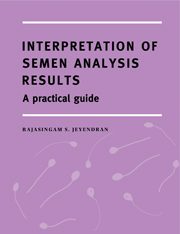Book contents
- Frontmatter
- Contents
- Preface
- Introduction
- Hypotheses on fertile ejaculate identification
- Male reproductive system background
- Semen analysis interpretation
- ROUTINE SEMEN ANALYSIS
- SPECIALIZED SEMEN ANALYSIS
- The logical sequence of routine and specialized semen analysis
- Semen component point-of-origin
- Conclusion
- Standard semen variable reference values for clinical interpretation and diagnosis (Table 1)
- Specialized semen test reference values for clinical interpretation and diagnosis (Table 2)
- Spermatozoa biochemical analysis and seminal plasma chemical analysis reference values for clinical interpretation and diagnosis (Table 3)
- Glossary
- Suggested additional reading
- Index
Male reproductive system background
Published online by Cambridge University Press: 05 August 2016
- Frontmatter
- Contents
- Preface
- Introduction
- Hypotheses on fertile ejaculate identification
- Male reproductive system background
- Semen analysis interpretation
- ROUTINE SEMEN ANALYSIS
- SPECIALIZED SEMEN ANALYSIS
- The logical sequence of routine and specialized semen analysis
- Semen component point-of-origin
- Conclusion
- Standard semen variable reference values for clinical interpretation and diagnosis (Table 1)
- Specialized semen test reference values for clinical interpretation and diagnosis (Table 2)
- Spermatozoa biochemical analysis and seminal plasma chemical analysis reference values for clinical interpretation and diagnosis (Table 3)
- Glossary
- Suggested additional reading
- Index
Summary
In an effort to provide background for the interpretative evaluation of semen analysis results, a brief description of the male reproductive system is provided. This should refresh the reader's basic knowledge, and provide a basic anatomical and physiological framework. The overview includes functional anatomy, endocrinology, emission and ejaculation, spermatozoa description, sexual stimulation, and semen collection.
Functional anatomy
The male sexual anatomy can arbitrarily be divided into four parts:
• The testis: male gonads producing the spermatozoa
• The epididymis and vas deferens: organs that mature, store, and transport spermatozoa
• The accessory sex glands: organs that supply most of the fluid portions (or seminal plasma) of the semen at ejaculation
• The penis: organ for the delivery of semen
The testis: male gonads producing the spermatozoa
The testicles are a pair of reproductive glands located outside the body within a skin pouch, the scrotum. They are each ovalshaped and approximately 25 milliliters in volume. They are designed to fulfil a double function: the production of sexual hormone, directly interrelated to its second function, the production of spermatozoa (spermatogenesis). Within the limits set by the flexible but unstretchable albuginea, the testis is composed of a large number of lobules. Each lobule consists of a large number of tubules (seminiferous tubules) all connected to the hilus and a marginal rete testis where the sperm are generated. The seminiferous tubules are surrounded by a basement membrane. Within the tubules, two types of cells are found: the ever-multiplying germ cells that ultimately result in the formation of spermatozoa, and Sertoli cells that provide the biochemical milieu for the support of the evolving germ cells in their intricate metamorphosis from spermatocyte, to spermatid, and finally to spermatozoon. Besides, the lobules also consist of cell clusters in the intertubular spaces (interstitial or Leydig cells) that constitute the endocrine part of the gonad. The interstitial tissue consists of collagenous fibers, blood and lymph vessels, and various types of connective cells.
Spermatogenesis is an elaborate cell differentiation process, starting with the germ cell (spermatogonia) and terminating with a fully differentiated highly specialized cell called the spermatozoon. The spermatogonia is located at the base of the seminiferous epithelium, and consists of two classes: Type A and Type B.
- Type
- Chapter
- Information
- Interpretation of Semen Analysis ResultsA Practical Guide, pp. 9 - 20Publisher: Cambridge University PressPrint publication year: 2000



